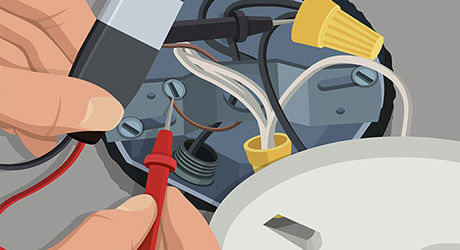
The first thing youll need to do to find a short circuit is to look for physical signs. If the tail light on the opposite side works its not a fuse.

This may include visible burns or metal on wires burning smells or flickering lights.
How to test a light socket with a multimeter. If you are doing this on the lamp prepare the power source and plug the lamp in. If you are working on the light socket in the ceiling it would be best and safer if you would remove it from the ceiling and use your own power source. Take your multimeter and prepare the multimeter standard test leads.
If you want a free hand you can replace the negative black standard probe. There are two procedures to check a light socket with a multimeter one of which requires the power to be on and another you can do with the power off. Advertisement The first test is a voltage test which you perform with the multimeter set.
If the tester lights up its working fine. If it fails to light up the tester is bad or needs new batteries. How do you test for a short circuit in a lighting circuit.
The first thing youll need to do to find a short circuit is to look for physical signs. This may include visible burns or metal on wires burning smells or flickering lights. To test an outlet with a multimeter read the instructions that came with your device first and be careful not to touch the metal prongs.
If you do you could be electrocuted. The process of checking an outlets voltage is quick and easy and you can also check the casing of an outlet to make sure its safe. All you need to test LED lights is a digital multimeter with a diode setting.
First connect the black and red test leads to the outlets on the front of the multimeter. Once the leads are connected switch the dial on the front of the multimeter clockwise to reach the diode setting. To test the socket you use the multimeter leads.
Hold the two leads in one hand to prevent shock and insert them into various slots on the socket to check voltage. To measure the voltage from the socket insert one lead into the live terminal right slot and the other into the neutral terminal left slot. How to test a light bulb for continuity with a multimeter.
If playback doesnt begin shortly try restarting your device. Videos you watch may be added to the TVs watch history and influence TV. Turn the dial to Rx1k to test continuity of the socket on the light fixture.
Touch one lead from your multimeter to the terminal that attaches the black wire to the back of the socket. Place the other lead in the socket and touch the contact tab in the sockets bottom. Touch one test lead to the metal tab in the sockets bottom center.
Touch the remaining lead to the threaded metal portion of the sockets interior. The tester lights up if the socket is receiving. Unscrew the bulb out of the socket and take the multimeter.
Set the multimeter to continuity mode. You can easily verify that you have correctly set the multimeter to continuity mode by pressing the probes together. If the multimeter is set on.
Turn the power off to the socket. Test the socket by attaching the clip of the continuity tester to the hot screw terminal the black wire lead. Then touch the probe to the metal tab in the bottom of the socket.
The tester should glow. If it doesnt the socket is faulty and needs to be replaced. If the multimeter does not register any power touch the probes to the wires protruding from the back of the socket.
If it reads at the back of the socket the socket connection is bad and needs to be replaced. If it does not move on to checking the vehicles fuse box which can be visually inspected without the use of a multimeter. - Remove the light fixture - Use a multimeter set to OHM and test the continuity between the wires and the socket.
No messing with live wires and no sticking multimeter probes into live sockets and extension cords. The no-contact pen thing that lights up and beeps when near live voltage works too but requires you to work with the electricity on. However if numerous bulbs fail to work appropriately in the same light socket you should then make use of a multimeter to check if the current is still flowing correctly.
This is due to the possibility of having a damaged switch hence the need to use a multimeter to test whether or not it still is functioning as needed. Test the tail light bulb socket with a digital multimeter. Set the meter to 12-volts DC.
Touch the black probe to a clean metal surface. Then probe the two terminals in the socket. You should see 12 volts.
If the test light doesnt light power isnt getting to the socket. If the tail light on the opposite side works its not a fuse. Test for power at the socketTurn on the light switch then ground the tester to a clean screw on the body of the car.
Probe the contacts to see if the tester lights. If the contacts look corroded scratch the surface but be careful not to bend or distort them. How to Test Complete Circuits in OnOff Sockets.
Turn the power to the socket on. You can check with your non-contact voltage tester to make sure its there. Turn your meter on and set it to read AC voltage often abbreviated as VAC.
If your meter is one that has selectable ranges within VAC set it to the lowest value that is greater.